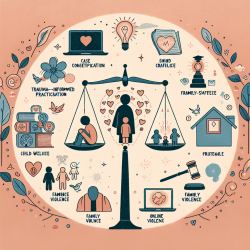Empowering Change: Understanding the Impact of Structural Racism on Community Health
As professionals dedicated to improving children's outcomes, it is imperative to understand the broader societal factors influencing their environments. The research article, "What explains the concentration of off-premise alcohol outlets in Black neighborhoods?" sheds light on the historical and structural factors contributing to health inequities in urban areas. This blog post aims to guide practitioners in speech-language pathology and related fields on how to leverage these insights for better community health outcomes.
Understanding the Research
The study examines the historical practice of redlining and its impact on the present-day concentration of alcohol outlets in minority neighborhoods. Redlining, a discriminatory practice institutionalized in the 1930s, designated certain areas as high-risk for mortgage lending, predominantly affecting Black and minority communities. This led to a higher density of alcohol outlets in these neighborhoods, contributing to various public health issues.
Key Findings
- Contemporary off-premise alcohol outlet densities are significantly higher in historically redlined areas.
- These areas also show higher concentrations of Black and Hispanic residents, with lower median household incomes.
- The study highlights the enduring effects of structural racism on urban planning and public health.
Implications for Practitioners
Understanding these dynamics is crucial for practitioners working with children in affected communities. By acknowledging the role of structural racism, practitioners can better tailor their interventions and advocate for policies that address these inequities. Here are some actionable steps:
- Engage in community advocacy to support equitable urban planning and zoning policies.
- Collaborate with local organizations to address the root causes of health disparities.
- Incorporate cultural competence into practice, acknowledging the historical context of the communities served.
Encouraging Further Research
This study underscores the importance of considering historical socio-political contexts in public health research. Practitioners are encouraged to delve deeper into how these factors influence child development and community health. By doing so, we can develop more effective strategies to support children and families in marginalized communities.
To read the original research paper, please follow this link: What explains the concentration of off-premise alcohol outlets in Black neighborhoods?










